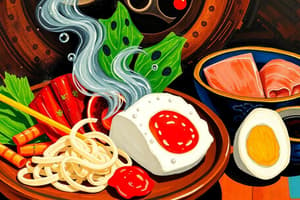Podcast
Questions and Answers
What is the focus of Washoku, traditional Japanese cuisine?
What is the focus of Washoku, traditional Japanese cuisine?
- Using complex preparation methods
- Creating visually appealing dishes
- Combining Japanese and Western flavors
- Emphasizing seasonality, local ingredients, and simple preparation methods (correct)
What is a unique ingredient commonly used in Japanese cuisine?
What is a unique ingredient commonly used in Japanese cuisine?
- Garlic
- Paprika
- Bamboo shoots (correct)
- Pineapple
What is an important aspect of dining etiquette in Japanese culture?
What is an important aspect of dining etiquette in Japanese culture?
- Leaving your chopsticks standing upright
- Not trying a little of each dish
- Waiting for the host to start eating (correct)
- Eating with your left hand
What is a common misconception about Japanese cuisine?
What is a common misconception about Japanese cuisine?
What is a strategy for collecting customer feedback in a Japanese restaurant?
What is a strategy for collecting customer feedback in a Japanese restaurant?
Flashcards are hidden until you start studying
Study Notes
Introducing Japanese Culture to Foreign Customers
Traditional Japanese Food
- Washoku: traditional Japanese cuisine emphasizing harmony, respect, and tranquility
- Focus on seasonality, local ingredients, and simple preparation methods
- Examples: sushi, ramen, tempura, and kaiseki (multi-course meal)
- Unique Ingredients:
- Seafood: raw fish (sashimi), seaweed, and seafood-based broths
- Vegetables: bamboo shoots, lotus root, and shiitake mushrooms
- Grains: Japanese rice, soba noodles, and udon noodles
- Dining Etiquette:
- Table manners: wait for the host to start eating, don't leave your chopsticks standing upright
- Respect for elders: offer food to the oldest person at the table first
- Try a little of each dish to show appreciation for the variety
Customer Feedback
- Cultural Differences:
- Direct vs. indirect communication styles
- High-context vs. low-context cultures (importance of relationships and group harmony)
- Common Misconceptions:
- Japanese cuisine is only raw fish (sashimi) - introduce variety of dishes
- Japanese food is expensive - offer affordable options
- Feedback Strategies:
- Open-ended questions to encourage feedback
- Comment cards or online review platforms
- Staff training to handle feedback and provide personalized recommendations
Traditional Japanese Food
- Washoku: emphasizes harmony, respect, and tranquility, focusing on local ingredients, seasonality, and simple preparation methods
- Popular Japanese dishes: sushi, ramen, tempura, and kaiseki (multi-course meal)
Key Ingredients
- Seafood: raw fish (sashimi), seaweed, and seafood-based broths
- Vegetables: bamboo shoots, lotus root, and shiitake mushrooms
- Grains: Japanese rice, soba noodles, and udon noodles
Dining Etiquette
- Table Manners:
- Wait for the host to start eating
- Avoid leaving chopsticks standing upright
- Respect for Elders: offer food to the oldest person at the table first
- Appreciation: try a little of each dish to show appreciation for the variety
Understanding Customer Feedback
- Cultural Differences:
- Direct vs. indirect communication styles
- High-context vs. low-context cultures (importance of relationships and group harmony)
- Common Misconceptions:
- Japanese cuisine is not just raw fish (sashimi)
- Japanese food can be affordable
- Feedback Strategies:
- Ask open-ended questions to encourage feedback
- Use comment cards or online review platforms
- Train staff to handle feedback and provide personalized recommendations
Studying That Suits You
Use AI to generate personalized quizzes and flashcards to suit your learning preferences.




